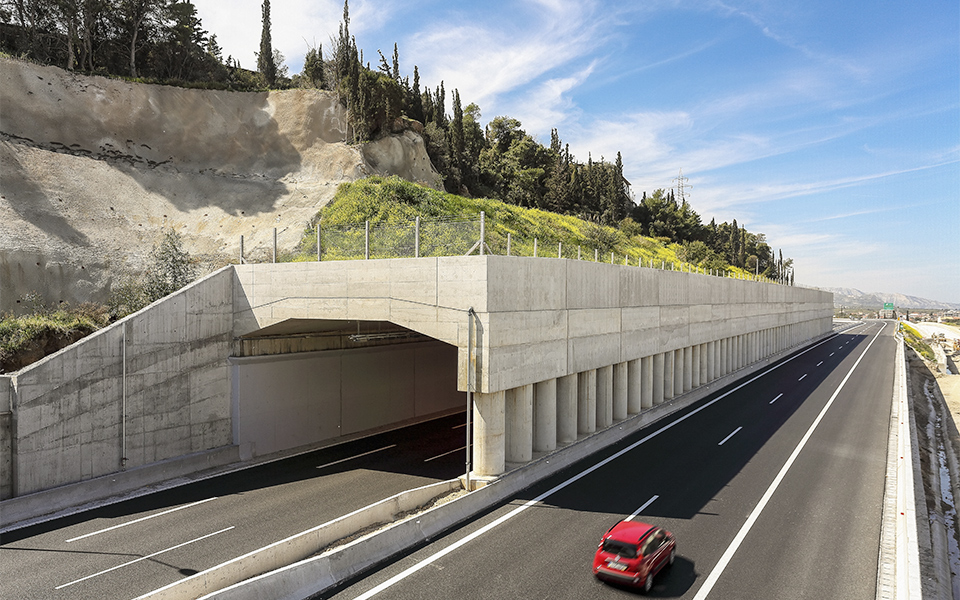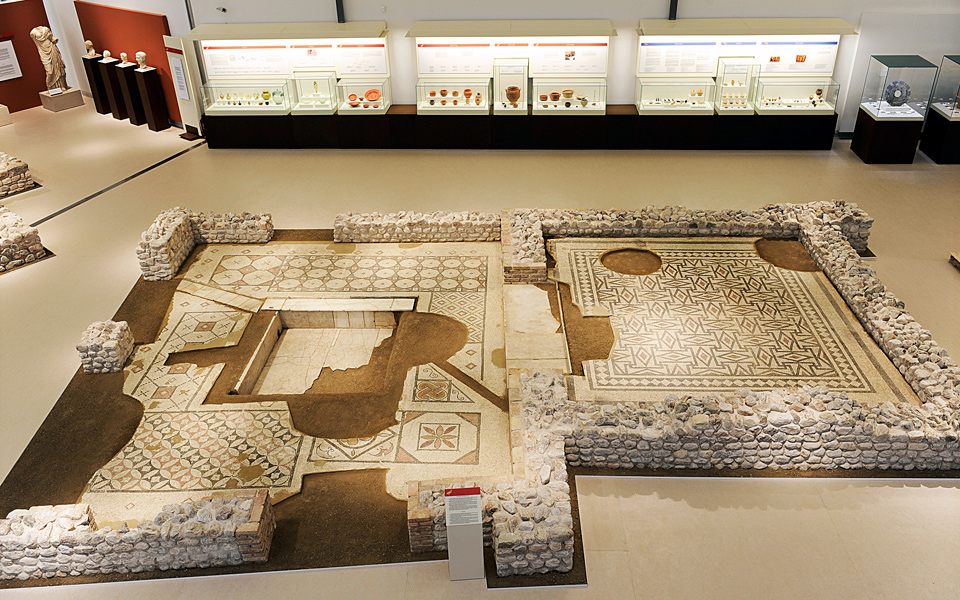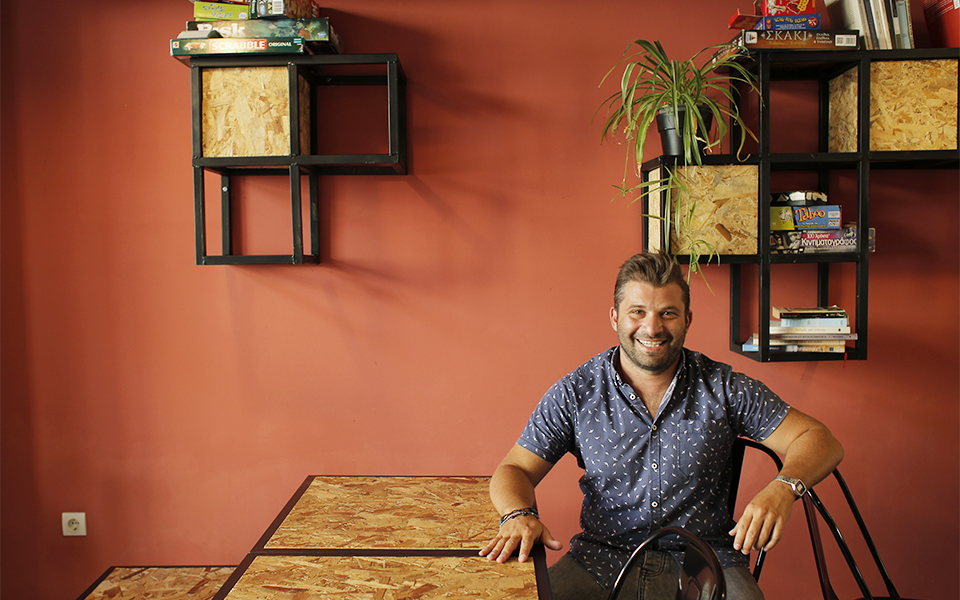In Georgiou I square, just in front of the architectural masterpiece of the Apollon theatre (designed by Ernst Ziller and built in 1872 ), a group of shirtless young men are doing tricks on their skateboards. On Gerokostopoulou street, a dog and his owner are people watching. At the fishing harbor, smoking fishermen gaze at us from their boats as we pass by.
Down by the beach, people swim and sunbathe against the backdrop of the enormous Rio bridge that links the Peloponnese to mainland western Greece. At the new port tourists watch the ferries as they prepare to set off for Ancona, Bari, and Brindisi, while at the farmer’s market that operates every Thursday, small farmers call at you to admire their goods; figs from Diakopto, potatoes from Achaia.

© Nikos Kokkas

© Nikos Kokkas

© Nikos Kokkas
Even in the late summer heat when we visited Patras, the city was full of life. And the best way to get to know it is on foot. Like most sizable Greek cities, Patras is more of a fall or winter destination than a place to spend summer vacations. However, the city seems to be entering a new phase, becoming more accessible thanks to the new Olympia Odos highway that extends along the northern coast of the Peloponnese, and has now replaced the old road from Athens that was a dangerous mess. Now it only takes one-and-a-half to two hours to get here from the capital, and the journey is infinitely safer than before.
Patras still has an aristocratic air that calls to mind a different age. One can see it in the gorgeous neoclassical buildings that are scattered throughout the town; one building on Aghiou Andreou street – the home of a gym now – looks like it’s been stolen straight from a Dickens novel. One can see it in the architecture of the churches – from the pompous but beautiful Aghios Andreas to the measured frugality of the Anglican church.



This enchanting side of Patras is also there in the taxicabs that are painted an old-fashioned burgundy, the retro bottles of “tentura” (a local digestif made with with cinnamon and cloves), and in the store windows full of Patras’ famous loukoumia (Turkish delight).
That said, this old-fashioned atmosphere also sometimes seems to be holding the city back. On first visiting Patras, one senses that it may be clinging to an old image of itself; one that perhaps makes it difficult to progress forward and find its place in the modern world.

© Nikos Kokkas

© Vangelis Zavos

© Nikos Kokkas
Of course, one advantage that Patras has over other major Greek cities is its intimate connection with the sea – via its ports (the old and the new), its marina and its southern seaside park where locals go to relax, jog and ride bikes.
Whether one is talking from a business, tourism, or aesthetic perspective, a city built by the edge of the sea is fortunate. Regardless of the ups and downs its may experience, it will always have the potential to improve, to grow, and to evolve. Below are 5 of our favourite things about Greece’s third largest city.

© Nikos Kokkas
1. “Mavrodafni” and history lessons at Achaia Clauss winery
“It takes time,” Periklis Baltas, manager of Achaia Clauss tells us once we’re finally finished with our marathon tour of the wine-making estate. He’s right. This place is a destination in and of itself. The country’s first organized winery was founded by the Bavarian Gustav Clauss, who came to Greece in the middle of the 19th century as a representative of a German company importing raisins from the country.
“He was mostly interested in dessert wines and cognac, so naturally, the first wine he produced here was a sweet one.” That was a Mavrodafni, the sweet red wine Patras is famous for. Achaia Clauss produces several other PDO (protected designation of origin) wines, such as the Moschato of Patras, and the Melissea Moschato. The latter is sweetened using an “age-old method of sun-ripening the grapes,” Baltas tells us.
Baltas can talk for hours about the character of the wines produced here, but what makes his stories fascinating are the connections he draws between the operation of the winery and the social and political situation of the time.
In the beginning, Clauss worked together with Germans, Greeks, and Maltese, meaning that “Within the estate, three separate religious communities coexisted peacefully: protestants, orthodox and catholic christians.” However, Baltas says, following his death in 1908 and the subsequent outbreak of WWI, the German community was expelled from Greece, and the winery passed to the hands of the Greek state as war reparations (!). It was later taken over by the family of the currant merchant, Vlasis Antonopoulos.

© Nikos Kokkas
2. The Archaeological Museum of the Future
As far as its archaeological museum goes, Patras’ gamble paid off. And this because the building that replaced the old archaeological museum in 2009, feels truly ‘modern’, with that term extending beyond just the newness of the facility. The flexible building (created by architects Bobotis + Bobotis) consists of asymmetric structures, a dome covered in titanium and an artificial lake (which, it must be said, is not always full) that is a reference to Patras’ perennial close relationship with water – i.e. the sea.
The permanent exhibition is displayed in three halls that explore different themes: “necropolis,” “private life,” and “public life”. We were especially impressed by a Mycenaean ceramic urn decorated with fish and octopi, a skull still adorned by a flower-decorated wreath, the amazing mosaic floors, and, of course, the Roman-era statue of Athena; a replica of the famous ivory and gold statue that was once housed in the Parthenon which was discovered in pieces at two different spots in 1896 and 1911.
Info
The Archaeological Museum of Patras
Open: every day 08.00-20.00
Tel.: (+30) 2613-616100
Entrance fee: 6 euro

© Nikos Kokkas
3. The Castle with a View
In the foothills of the Panahaikos mountain range, built on the ruins of an ancient city, you will find the Castle of Patras. The castle bears the scars and marks left by the important historical events that befell the city.
It was besieged by Slavs and Saracens, and captured by the Byzantine emperor Constantine Paleologos. The Ottomans used it as a command center. It was damaged during the Orlov revolt, and rocked by a strong earthquake in the 19th century.
Aside from its historical interest, a walk up to the castle is worth the effort just to see the view of Patras from above. Some tiled roofs, marking the neoclassical houses, are scattered among the many blocks of apartment buildings below.
Info
The Castle of Patras
Open Tuesday-Sunday 08.00-15.00
Tel.: (+30) 2610-623390
Entrance is free

© Nikos Kokkas

© Nikos Kokkas
4. Loukoumia and Tentura Liqueur at the Hahali Bros.
Barrels of sherry brandy, shelves packed with bottles, an old mock-up for an advert touting the offerings of the Hahali Bros., boxes of tentura-flavored loukoumia and bottles of orange liqueur stacked on top of each other like Legos.
The shop of the Kastro distillery (which was founded by Georgios Hahalis in Chios in the 19th century, and transferred to Patras by Panagiotis Hahalis in 1939 where it thrived) is a haven for lovers of aromatic alcoholic drinks (flavored with ginger, thyme, mint, and even grapefruit), and especially for those who like Patras’ traditional liqueur Tentura, (which is even used to flavor pastilles). Or shop here just for the atmosphere with the retro design of the products presented in a stylish, tasteful setting.

© Nikos Kokkas
5. Building Bridges over Sunday brunch at Gefyres
“The contractors, the carpenters, the electricians, architect Tatiana Dimou, artist Kleomenis Kostopoulos, the members of SOPSY (Patra’s Association for Mental Health)…So many people helped create this place from nothing,” Lambros Arapakos, a social worker with SOPSY, says about “Gefyres” (Bridges).
Gefyres, on Patreos street is a special place with deep red walls and a beautiful garden staffed by individuals who have suffered from mental health issues. The cafe frequently hosts cultural events (from book readings to movie nights and live music), and is famous for its Sunday brunch (serving croque monsieurs, croque madames, marbled cakes, and crepes).
But people also come here for the warm hospitality shown by the people who work here. One of the latter is Mina, who we met, a professional who loves what she does. “It is a social job; I get to interact with people and serve them with hospitality and a smile. And you get the same energy right back.” Drop by for a coffee!
Info:
Gefyres
86 Patreos. Tel. +30 2610.623963.
The café is sponsored by VINCI Concessions (a majority shareholder of Olympia Odos and Gefyra S.A).












